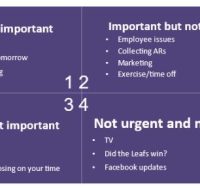Time Management Tips Tuesdays: Task Management – Focusing on Priorities

Identify Your Priorities
Stephen Covey, author of The 7 Habits of Highly Effective People, developed a matrix approach to setting priorities, based on four quadrants. Here’s a sample matrix:

Items in box 1 are mission critical – do them now. Items in box 2 you can schedule to do at a future point. Items in box 3 can be delegated. And items in the 4th quadrant consider whether you should be doing them.
Use this matrix to move from feeling like you’re drowning in tasks to swimming towards goals.
Embrace To-Do Lists
To start, embrace your to-do list. A few points to start:
It doesn’t matter whether you use paper or an electronic list – just start
If electronic – there are lots of tools to pick from – Google Docs, Word, One Note, Evernote, are just a few
Different people have different approaches. Try some out. Some options include:
- Bullet journaling – where each item gets jotted down as you go.
- Arrange by order of priority
- Use different colours / fonts to track more easily.
There are different to-do lists you should keep:
Global To Do List
- This should include all key to-do items
- Review at the start of each day to decide what you’ll be working on
- Regularly review the global list of items to ensure it’s current
Daily to Do List + The Power of 3
- At the start of your day, from your Global To Do List, decide on what you’re working on today (Cue)
- Pick your top priorities – pick no more than 3 items at a time. (There’s no magic to this number. It’s a digestible task list. If you prefer, try a different number that is manageable.) By keeping a realistic sense of tasks to get done in a work day, you reduce stress, create realistic expectations for yourself, and can celebrate the small wins as you go.
- When the item is completed, take a moment to pat yourself on the back. Strike it off the To-Do List.
- Repeat!
Capture “Aha” Moments and Smaller Tasks
While engaged in work, there are smaller “aha” moments and other items you need to note. Whether it’s a great idea as your mind wanders off task, the reminder to pick up groceries on the way home from work, or key information from an unexpected phone call you need to note at once, it’s important to capture the information for later, while returning quickly to your task on hand.
Here too there’s no wrong way to do it. For the little items you can:
Use sticky notes, a note pad, email yourself a reminder, or add a note into an electronic file
Then at a break for batch work, or towards the end of the day, add the note to your To-Do list if appropriate
Stop Doing List
Similar to the Subtract tip from last week’s post, consider creating a “Stop Doing” list. Some tasks probably don’t need to be done, or that you should set up to no longer do. Using a “stop doing” list reminds you that your time is valuable, and that certain tasks or distractions can be eliminated. Ask why you are doing something? Is it simply because you have always done something? It is necessary? If not, maybe there is nothing lost by cutting the task entirely from your practice and freeing up your time. Less can be more.
Next week we’ll focus on client and file management tips to keep you on course. Subscribe to the avoidaclaim.com blog to have the post emailed right to you. Got a question? Reach out to [email protected].

Leave a Reply